Disciplinary Action Considerations
Cases of Sexual Assault, Intimate Partner Violence and Stalking
Considerations for assigning disciplinary actions:
Each case has unique facts and circumstances and should be evaluated based on those facts and circumstances. Keep in mind that unique facts and circumstances of each case may result in varying disciplinary actions. When a Student Conduct Officer or other decision maker in the conduct process is determining the appropriate disciplinary action or combination of disciplinary actions for a student, the following factors should be considered:
The Nature of the Violation
How serious is the violation? Who was harmed?
What were the outcomes?
Developmental and Educational Impact for Individual and Community
What message does this disciplinary action send to the community and the student? What can the disciplinary action teach a student? How can the disciplinary action help a student develop as a community member and individual? What do the parties think is an appropriate disciplinary action?
Prior Violations/Previous Conduct History
Does the student have other violations and disciplinary actions on record? This consideration is used only in the assignment of disciplinary actions, not in the finding of responsibility.
Eligibility for Good Conduct Standing
Should the student be in good conduct standing if found responsible?
Mitigating/Aggravating Circumstances Surrounding the Incident
What were the special circumstances surrounding the situation?Mitigating circumstances may result in lesser disciplinary actions. Aggravating circumstances may result in more severe disciplinary actions.
Additional Factors Considered May Include:
- Use of force
- Use of weapons
- Incapacitation
- Threats to the community
- Coercion
- Manipulation
- Repeat violations
- Penetration
Motivation for the Behavior
Why did the student engage in the behavior? Was there evidence of malicious intent?
Definitions of Disciplinary Actions
Written Warning:
A written admonition to a student that they have violated the Code and must not engage in future violations. A written warning does not change the student’s conduct standing with the institution.
Disciplinary Probation:
A written notice for a specified period of time in which a student or student organization is given the opportunity to demonstrate adherence to the expectations set out in the Code and is subject to more serious disciplinary action for any future misconduct. Disciplinary probation may be assigned for the duration of a student’s enrollment at the institution. Students on probation are not in good conduct standing with the institution.
Suspension:
Removal from HSC for a specified period of time, not to exceed one (1) year; during which the student is not eligible to enroll at HSC and may be banned from HSC premises until the period of suspension expires. A suspension is noted on the transcript until all conditions of the disciplinary action have been met. A student must be cleared for re-enrollment by appropriate HSC officials. If allowed to return, the student will be placed on disciplinary probation for the remainder of the student’s enrollment. A suspension is maintained in the student’s behavioral record. Students on suspension are not in good conduct standing with the institution.
Expulsion:
Permanent separation from HSC. An expelled student is permanently removed from enrollment at HSC and permanently banned from HSC premises. Expulsion is reflected in a student’s permanent academic and behavioral record.
Loss of Privileges:
A temporary or permanent loss of the opportunity to participate in programs, activities or services offered by the institution, or to receive the benefits of being an HSC student or registered student organization. Loss of privileges may include the restriction of specific locations (e.g. access to the Library or Fitness Center) or the restriction of specific activities and services (e.g. group exercise classes or computing resources).
Restitution:
A requirement to reimburse the institution for damage caused to HSC property due to misconduct.
Restitution that has not been addressed may impact a student’s ability to enroll in subsequent semesters.
Transcript Notation for Suspensions and Expulsions:
As noted in the Student Code of Conduct and Civility, the disciplinary actions of suspension and expulsion will be noted on the student’s transcript once the action becomes final.
Suspension:
The transcript notation will read: “Student Code of Conduct Status: Suspension.” The suspension status will be removed upon notification from the Office of Care and Civility that the suspension has been completed.
Expulsion:
The transcript notation will read: “Student Code of Conduct Status: Expulsion.” The expulsion
notation is permanent.

Sexual Harassment Examples
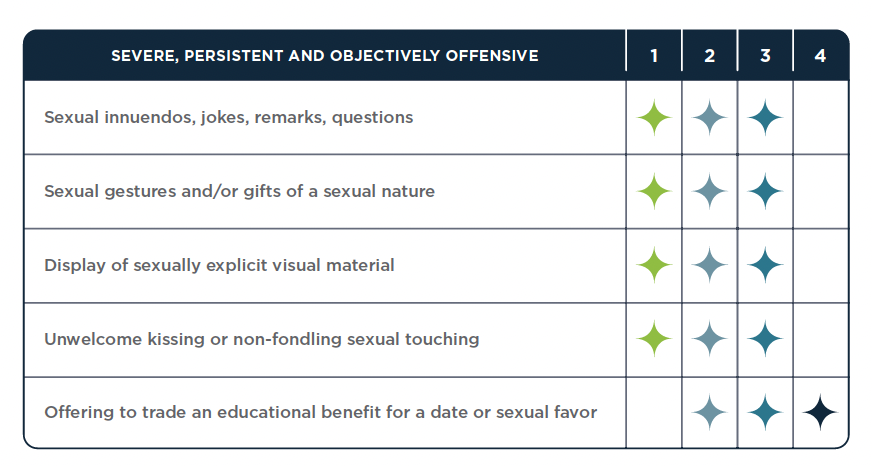
Factors to Consider When Determining Disciplinary Action
Mitigating Factors:
- The behavior was committed in error, by mistake or was unintentional.
- Prior instances where respondent’s similar advances were welcome.
- Impact statements of respondent and complainant.
Aggravating Factors:
- The harm caused by the deprivation of access/benefits/opportunities was lengthy, extensive or irreparable.
- The totality of the behavior was exceptionally severe, persistent and objectively offensive.
- The harassment was threatening, intimidating or aggressive.
- The respondent violated a No Contact Directive.
- Impact statement of respondent and complainant.
- Prior history of misconduct (i.e., found in violation of university policy through formal process).
- Cumulative violations.

Stalking Examples
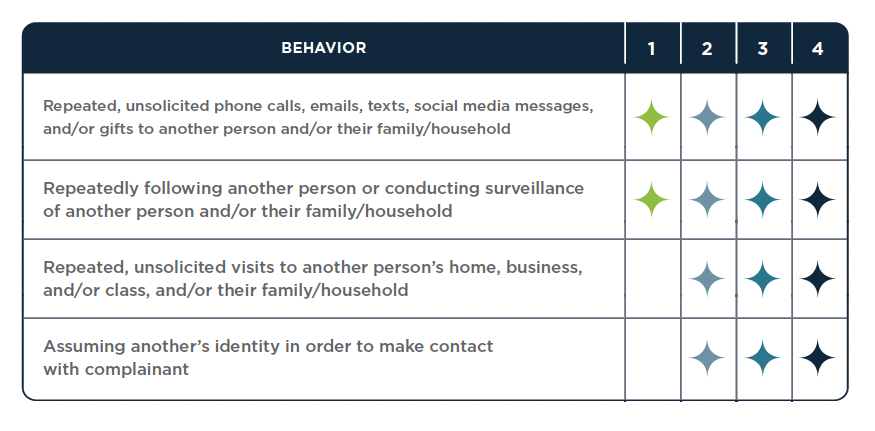
Factors to Consider When Determining Disciplinary Action
Mitigating Factors:
- The respondent exhibited signs of a documented disability or demonstrated below-average social skills and/or an inability to perceive and understand normal social cues or conventions.
- Evidence that respondent may not have reasonably known that their conduct was regarded as unwelcome.
- Impact statements of respondent and complainant.
Aggravating Factors:
- Impact statements of respondent and complainant.
- The respondent’s refusal to stop the conduct after being told that their behavior was unwelcome.
- The respondent’s behavior was excessive, pervasive, aggressive and/or violent.
- Prior history of misconduct (i.e., found in violation of university policy through formal process).
- Cumulative violations.

Sexual Misconduct Examples
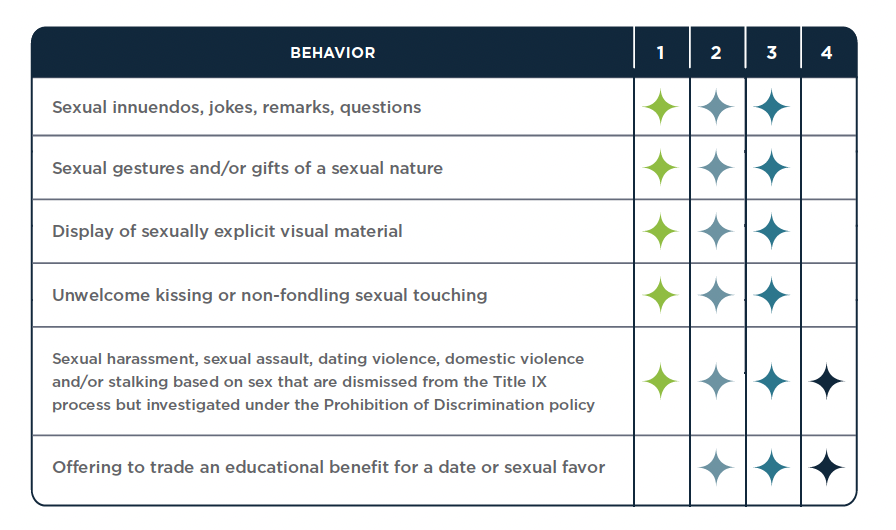
Factors to Consider When Determining Disciplinary Action
Mitigating Factors:
- The behavior was committed in error, by mistake or was unintentional.
- Prior instances where respondent’s similar advances were welcome.
- Impact statements of respondent and complainant.
Aggravating Factors:
- The harm caused by the deprivation of access/benefits/opportunities were lengthy, extensive or irreparable.
- The totality of the behavior was exceptionally severe, persistent and objectively offensive.
- The harassment was threatening, intimidating or aggressive.
- The respondent violated a No Contact Directive.
- Impact statements of respondent and complainant.
- Prior history of misconduct (i.e., found in violation of university policy through formal process).
- Cumulative violations.

Retaliation Examples

Factors to Consider When Determining Disciplinary Action
Mitigating Factors:
- Impact statements of respondent and complainant.
- The harm caused by the retaliation was minimal.
Aggravating Factors:
- The behavior occurred multiple times.
- Impact statements of respondent and complainant.
- The respondent’s use of force or physical violence.
- The respondent’s use of a weapon.
- The complainant and/or community experienced a substantial amount of harm.
- The respondent violated a No Contact Directive.
- The respondent was in a position of power or authority over the complainant.
- Prior history of misconduct (i.e., found in violation of university policy through formal process).
- Cumulative violations.

Sexual Exploitation Examples
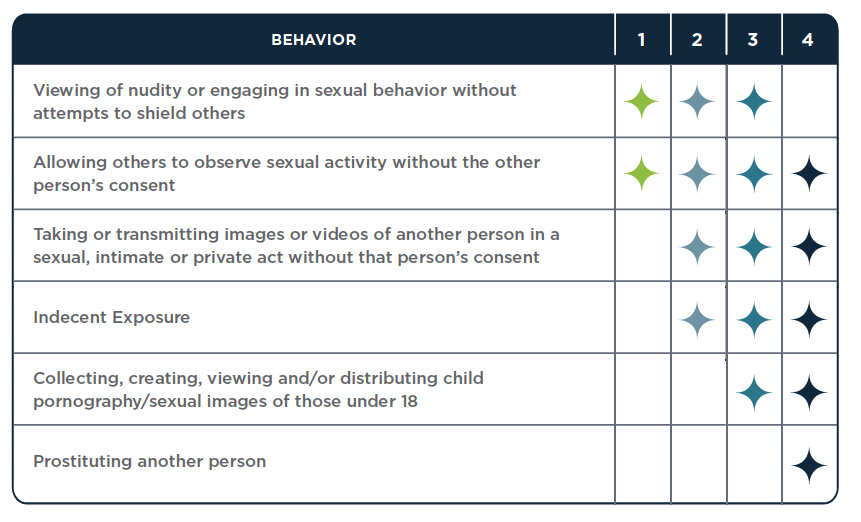
Factors to Consider When Determining Disciplinary Action
Mitigating Factors:
- Prior instances where the photography or recording was consensual between the parties, thereby creating ambiguity of consent in the current instance.
- The transmittal was accidental
- Impact statements of respondent and complainant.
Aggravating Factors:
- The respondent was in a position of power or authority over the complainant.
- The respondent used manipulation or misrepresentation to exploit the complainant.
- The private/intimate/sexual acts photographed or recorded were highly explicit.
- The non-consensual dissemination of the private/intimate/sexual acts was premeditated, extensive,
- pervasive and/or exposed the complainant to a large number of people.
- The complainant’s identity was clear or easily discernible to viewers.
- The complainant experienced a substantial amount of harm, embarrassment or humiliation.
- The respondent’s disclosure of private/intimate/sexual material was vengeful, malicious or retaliatory.
- The behavior (e.g., voyeurism, non-consensual dissemination, etc.) occurred multiple times.
- Impact statements of respondent and complainant.
- The respondent violated a No Contact Directive.
- Prior history of misconduct (i.e., found in violation of university policy through formal process).
- Cumulative violations.

Sexual Assault Examples
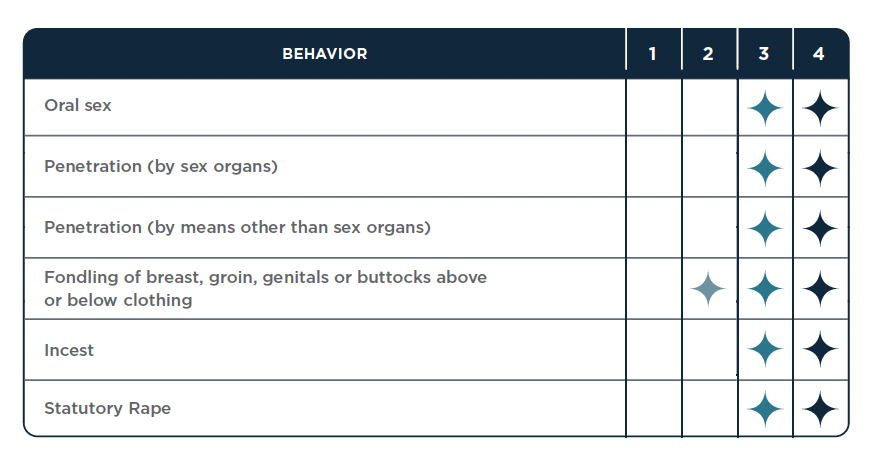
Factors to Consider When Determining Disciplinary Action
In Cases of Rape, Incest and Statutory Rape
Mitigating Factors:
- Consent was ambiguous.
- The respondent’s behavior, though non-consensual, did not exhibit a deliberate disregard for the dignity and autonomy of the complainant, but instead appeared to be an error in judgment, possibly affected by drug or alcohol use.
- The respondent’s behavior was not malicious.
- Impact statements of respondent and complainant.
Aggravating Factors:
- Impact statements of respondent and complainant.
- The respondent’s use of force or physical violence in the perpetration of the non-consensual sexual intercourse.
- The respondent’s use of a weapon or restraints.
- The respondent threatened bodily injury or intimidated the complainant.
- The use of drugs or alcohol to intentionally incapacitate the complainant.
- The respondent’s brazen refusal to desist the conduct after consent had been clearly revoked.
- The respondent’s behavior was predatory.
- The respondent was in a position of power or authority over the complainant.
- Prior history of misconduct (i.e., found in violation of university policy through formal process).
- Cumulative violations.
Factors to Consider When Determining Disciplinary Action
In Cases of Fondling
Mitigating Factors:
- Prior instances where the respondent’s sexual contact was welcome, thereby creating ambiguity of consent in the current instance.
- The sexual contact was (relatively) minimally invasive, such as a grazing touch rather than a prolonged squeeze, or the contact was over the clothes rather than under.
- The sexual contact was relatively brief.
- Impact statements of respondent and complainant.
Aggravating Factors:
- Impact statements of respondent and complainant.
- The fondling was comparatively more invasive, such as a respondent reaching under the complainant’s clothes or engaging in more vigorous or aggressive fondling rather than merely touching.
- The fondling was extensive.
- The fondling was aggressive or violent.
- The respondent continued the fondling after the complainant communicated, verbally and/or nonverbally, that it was unwelcome.
- The respondent was in a position of power over the complainant.
- Prior history of misconduct (i.e., found in violation of university policy through formal process).
- Cumulative violations.
Administrative and Non-Disciplinary Measures
The Student Conduct Officer may direct administrative, non-disciplinary action to protect the health, safety or welfare of the HSC community. Administrative measures may be taken before, during, after and outside of the student conduct process.
A. Interim Withdrawal
A student may be removed from all or part of HSC premises and prohibited from participating in any
academic programs or other HSC-related activities pending completion of the conduct process when the
institution reasonably believes that the student poses a direct threat to the health, safety or welfare of any member of the campus community or HSC property.
1. Conference Regarding Interim Withdrawal
A student who receives a
Notice of Interim Withdrawal
must contact the EDSAS
within two (2) business days of
receiving the notice to schedule
a conference to discuss: (1)
evidence supporting the alleged
misconduct; and (2) whether
the continued presence of
the student on HSC premises
reasonably presents a direct
threat pending completion of the
conduct process.
2. Decision Regarding Interim Withdrawal
If the EDSAS determines that the
student presents a direct threat,
the student will be immediately
withdrawn from HSC premises,
including all events and activities.
The interim withdrawal remains in
effect until the conduct process
is complete or until otherwise
altered. The EDSAS may review
the decision at any time and
permit the student to return to
HSC premises while the conduct
process continues.
3. Request for Review
A request for review can be
submitted for decisions of interim
withdrawal to the Vice Provost
for Student Affairs “VPSA” within
five (5) business days. During
the review process, the interim
withdrawal remains in effect.
B. No Contact Directive
A directive from the institution to cease all communication and contact with one or more individuals for a specified period when the institution reasonably believes the directive is necessary to protect the health, safety or welfare of any member of HSC or the campus community, including to prevent retaliation or harassment. The directive prohibits the student from communicating or contacting the identified individuals through friends, relatives, acquaintances, social media or other means, except as set out in the directive.
Account Hold for Participation in the Title IX Process:
The university shall not issue a transcript to the respondent until a final determination of responsibility is made.

Social media